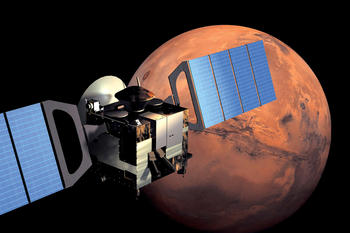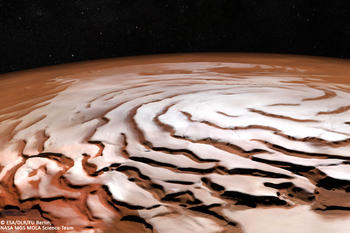A Sightseeing Trip with the Mars Express
The Planetary Sciences and Remote Sensing unit at Freie Universität has been studying the Red Planet for 14 years.
Oct 05, 2017
The Mars Express space probe operated by the European Space Agency has been circling Mars for nearly 14 years now. On board is an HRSC camera, which records nine channels at once.
Image Credit: ESA - Illustration by Medialab
An icy north pole: Even in the summer half of the year, when most of the pictures for this mosaic were taken, temperatures at Mars’s north pole hover below minus 50 degrees Celsius.
Image Credit: ESA/DLR/FU Berlin, NASA MGS MOLA Science Team
Dark chasms where dunes of black sand have accumulated weave between ice-capped hills. The Mars Express space probe takes us along on a flight above the ice cap at the Martian north pole and through canyons and valleys, past craters and across barren landscapes – volcanoes, sand dunes, and ice fields.
The fact that we can see these stunning images of the second-smallest planet in the solar system up close, in color and in 3D, is made possible by a high-performance camera called the High Resolution Stereo Camera (HRSC), which is operated by the German Aerospace Center (DLR). Never before have there been such detailed images of the surface of Mars. For nearly 14 years now, the special camera has been circling the Red Planet aboard the Mars Express space probe operated by the European Space Agency (ESA). “The mission was originally scheduled to last two years,” says Heike Balthasar. “It’s truly astonishing that the probe has been in flight this long, that the instruments are still working, and most of all, that the camera is still taking good pictures,” she adds.
Balthasar, who holds a Diplom degree in geography, is a member of the “Mars Express/HRSC Experiment” project group within the Planetary Sciences and Remote Sensing unit at the Institute of Geological Sciences at Freie Universität Berlin. Among the group’s other activities, it has been preparing three-dimensional images and videos based on the data transmitted by the camera ever since the mission started. By now, 76 percent of the surface of Mars has been charted at a resolution of less than 20 meters per pixel. “The big goal is to have a global mosaic of the entire surface of Mars,” Balthasar explains. “People are hard at work on that. We hope the camera will keep running right up until the last gaps have been filled.”
The pictures of the north pole, a volcano, and vast impact basins are compiled from many individual images. It is problematic that there are gaps in the images from areas not yet visited by the space probe, and that the quality of the image material varies, says Stefanie Musiol. Musiol, who earned her doctorate in geophysics, is also a researcher at the Planetary Sciences and Remote Sensing unit. She wrote her dissertation on Martian volcanoes based on image data from the HRSC.
“Mars has dust, dust storms, and clouds. Sometimes there is ice or snow cover, while at other times the surface is completely clear. But we also get different images of the same area because the sun is at a different angle or it is a different season. The surface itself also changes, for example as dunes move. But it makes our work even more exciting that we are still receiving great new pictures of Mars after this many years.”
The Mars Express mission was launched in June 2003 with a Soyuz-Fregat rocket from the Russian spaceport in Baikonur, Kazakhstan. It reached the planet six months later. The probe has been in elliptical orbit around Mars ever since. Its minimum distance from the Martian surface is about 270 kilometers, with a maximum of about 11,000. The probe takes about seven hours to complete one orbit of Mars.
The High Resolution Stereo Camera on board was developed at the DLR under the leadership of Professor Gerhard Neukum and built in cooperation with industry partners. Neukum was a professor of planetary sciences and remote sensing at Freie Universität from 2002 until 2012. The HRSC is the first camera system to be able to visualize the surface of Mars in high resolution, in color, and in three dimensions all at once. The raw data undergo several stages of pre-processing at the DLR Institute of Planetary Research in Berlin’s Adlershof district, before being further processed at Freie Universität.
Just recently, at the start of this year, the High Resolution Stereo Camera project at Freie Universität Berlin was extended for the fifth time. It is slated to receive just under 2.7 million euros in funding from the German Federal Ministry for Economic Affairs and Energy between now and late 2019, with support from the DLR Space Administration. ESA plans to decide by the end of this month whether there will be a further mission extension after that. “There’s still plenty of fuel,” Musiol says. “But that could change from one day to the next if it becomes necessary to fly additional maneuvers to adjust the probe’s orbit.”
This text originally appeared in German as a research news published by Freie Universität.


